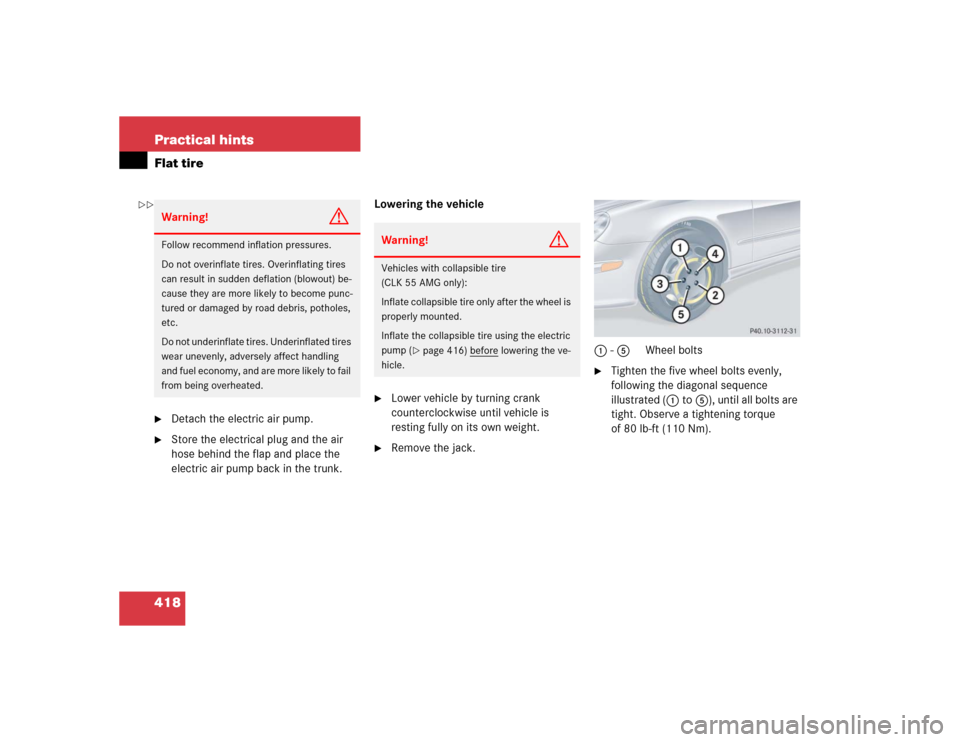Page 343 of 498

341 Operation
Tires and wheels
Rotating tires
Tire rotation can be performed on vehicles
with tires of the same dimension all
around. If your vehicle is equipped with
tires of the same dimension all around,
tires can be rotated, observing a a
front-to-rear rotation pattern that will
maintain the intended rotation (spinning)
direction of the tire (
�page 319).
In some cases, such as when your vehicle
is equipped with mixed-size tires (different
tire dimension front vs. rear), tire rotation
is not possible.If applicable to your vehicle’s tire configu-
ration, tires can be rotated according to
the tire manufacturer’s recommended in-
tervals in the tire manufacturer’s warranty
pamphlet located in your vehicle literature
portfolio. If none is available, tires should
be rotated every 3 000 to 6 000 miles
(5 000 to 10 000 km), or sooner if neces-
sary, according to the degree of tire wear.
The same rotation (spinning) direction
must be maintained (
�page 319).
Rotate tires before the characteristic tire
wear pattern becomes visible (shoulder
wear on front tires and tread center wear
on rear tires).
Thoroughly clean the mounting face of
wheels and brake disks, i.e. the inner side
of the wheels/tires, during each rotation.
Check for and ensure proper tire inflation
pressure.For information on wheel change, see the
“Practical hints” section (
�page 389) and
(
�page 412).
Warning!
G
Rotate front and rear wheels only if the tires
are of the same dimension.
If your vehicle is equipped with mixed-size
tires (different tire dimensions front vs.
rear), tire rotation is not possible.
Warning!
G
Have the tightening torque checked after
changing a wheel. Wheels could become
loose if not tightened with a torque of
80 lb-ft (110 Nm).
Only use genuine Mercedes-Benz wheel
bolts specified for your vehicle’s rims.
Page 420 of 498

418 Practical hintsFlat tire�
Detach the electric air pump.
�
Store the electrical plug and the air
hose behind the flap and place the
electric air pump back in the trunk.Lowering the vehicle
�
Lower vehicle by turning crank
counterclockwise until vehicle is
resting fully on its own weight.
�
Remove the jack.1 - 5Wheel bolts
�
Tighten the five wheel bolts evenly,
following the diagonal sequence
illustrated (1to5), until all bolts are
tight. Observe a tightening torque
of 80 lb-ft (110 Nm).
Warning!
G
Follow recommend inflation pressures.
Do not overinflate tires. Overinflating tires
can result in sudden deflation (blowout) be-
cause they are more likely to become punc-
tured or damaged by road debris, potholes,
etc.
Do not underinflate tires. Underinflated tires
wear unevenly, adversely affect handling
and fuel economy, and are more likely to fail
from being overheated.
Warning!
G
Vehicles with collapsible tire
(CLK 55 AMG only):
Inflate collapsible tire only after the wheel is
properly mounted.
Inflate the collapsible tire using the electric
pump (
�page 416) before
lowering the ve-
hicle.
��
Page 421 of 498
419 Practical hints
Flat tire
Before storing the jack, it should be fully
collapsed, with handle folded in (storage
position) (
�page 391).
�
Store the jack and the other vehicle
tools in the trunk.Warning!
G
Have the tightening torque checked after
changing a wheel. The wheels could come
loose if they are not tightened to a torque
of 80 lb-ft (110 Nm).
Page 440 of 498

438 Technical dataEngineModel
CLK 320 (209.365)
1
1The quoted data apply only to the standard vehicle. See an authorized Mercedes-Benz Center for the corresponding data of all special bodies and special equipment.
CLK 500 (209.375)
1
CLK 55 AMG (209.376)
1
Engine
112
113
113
Mode of operation
4-stroke engine, gasoline injec-
tion
4-stroke engine, gasoline injec-
tion
4-stroke engine, gasoline injec-
tion
No. of cylinders
6
8
8
Bore
3.54 in (89.90 mm)
3.82 in (97.00 mm)
3.82 in (97.00 mm)
Stroke
3.31 in (84.00 mm)
3.31 in (84.00 mm)
3.62 in (92.00 mm)
Total piston displacement
195.2 cu in (3 199 cm
3)
303.0 cu in (4 966 cm
3)
331.8 cu in (5 439 cm
3)
Compression ratio
10:1
10:1
11:1
Output acc. to SAE J 1349
215 hp / 5 700 rpm
2
(160 kW / 5 700 rpm)
2Premium fuel required. Performance may vary with fuel octane rating.
302 hp / 5 600 rpm
2
(225 kW / 5 600 rpm)
362 hp / 5 750 rpm
2
(270 kW / 5 750 rpm)
Maximum torque acc. to SAE J
1349
229 lb-ft/ 3 000-4 600 rpm
(310 Nm / 3 000-4 600 rpm)
339 lb-ft / 2 700-4 250 rpm
(460 Nm / 2 700-4 250 rpm)
376 lb-ft / 4 000 rpm
(510 Nm / 4 000 rpm)
Maximum engine speed
6000 rpm
6000 rpm
6700 rpm
Firing order
1-4-3-6-2-5
1-5-4-2-6-3-7-8
1-5-4-2-6-3-7-8
Poly-V-belt
2380 mm
2380 mm
2380 mm
Page 446 of 498
444 Technical dataElectrical systemModel
CLK 320
CLK 500
CLK 55 AMG
Generator (alternator)
14 V/120 A
14 V/150 A
14 V/150 A
Starter motor
14 V/1.4 KW
14 V/1.7 KW
14 V/1.7 KW
Battery
12 V/100 Ah
12 V/100 Ah
12 V/100 Ah
Spark plugs
Bosch F8 DPP 332
NGK PFR 5R-11
Bosch F8 DPP 332
NGK PFR 5R-11
NGK ILFR 6A
Electrode gap
0.039 in (1.00 mm)
0.039 in (1.00 mm)
0.031 in (0.8 mm)
Tightening torque
18.5 - 22 lb-ft (25 - 30 Nm)
18.5 - 22 lb-ft (25 - 30 Nm)
18.5 - 22 lb-ft (25 - 30 Nm)
Page 460 of 498

458 Technical termsMultifunction steering wheel
Steering wheel with buttons for operat-
ing the control system.
OCS
(O
ccupant C
lassification S
ystem)
The system automatically turns the
front passenger front air bag on or off
based on the classified occupant size
category determined by weight sensor
readings from the seat.
Overspeed range
Engine speeds within the red marking
on the tachometer dial. Avoid this en-
gine speed range, as it may result in se-
rious engine damage that is not
covered by the Mercedes-Benz Limited
Warranty.Parktronic (Parking assist)*
System which uses visual and acoustic
signals to assist the driver during park-
ing maneuvers.
Poly-V-belt drive
Drives engine-components (alternator,
AC compressor, etc.) from the engine.
Power train
Collective term designating all compo-
nents used to generate and transmit
motive power to the drive axles, includ-
ing
�
engine
�
clutch/torque converter
�
transmission
�
transfer case
�
drive shaft
�
differential
�
axle shafts/axlesProgram mode selector switch
Used to switch the automatic transmis-
sion between standard operationS and
comfort operationC.
CLK 55 AMG with steering wheel gear-
shift control and manual shift program:
In addition toS andC (for standardS
or comfortC operation, see above) you
can use theM for manual shift
program.
Page 462 of 498

460 Technical termsTele Aid System
(T
elematic A
larm I
dentification on D
e-
mand)
The Tele Aid system consists of three
types of response: automatic and man-
ual emergency, roadside assistance
and information. Tele Aid is initially ac-
tivated by completing a subscriber
agreement and placing an acquain-
tance call.
The Tele Aid system is operational pro-
vided that the vehicle’s battery is
charged, properly connected, not dam-
aged and cellular and GPS coverage is
available.
Telematics*
A combination of the terms “telecom-
munications” and “informatics”.Tightening torque
Force times lever arm (e.g. a lug
wrench) with which threaded fasteners
such as wheel bolts are tightened.
Tire speed rating
Part of tire designation; indicates the
speed range for which a tire is ap-
proved.
Traction
Force exerted by the vehicle on the
road via the tires.VIN
(V
ehicle I
dentification N
umber)
The number set by the manufacturer
and placed on the body to uniquely
identify each vehicle produced.
Voice control system*
Voice control system for car phones,
portable cell phones and audio sys-
tems (radio, CD, etc.).
Page 488 of 498

486 IndexTele Aid 280
Emergency calls 281
Information 284
Initiating an
emergency call manually 282
Messages in display 386
Remote door unlock 286
Roadside Assistance 283
Stolen vehicle tracking services 286
System self-check 280
Tele Aid System 280
Upgrade signals 285
Tele Aid System 460
Telematics* 460
Telephone* 26, 279
Answering a call 163
Dialing a number
from the phone book 163
Ending a call 163
Hands-free microphone 29
Loading phone book* 163
Messages in display 388
Operating 162
Operation 232
Redialing 164Temperature
Display mode 149
Setting interior temperature 187
Setting units in display 149
Tires 326
Tie-down rings (Trunk) 271
Tightening torque 460
Tightening torque (Wheel bolts) 418
Time
Setting hours 152
Setting minutes 152
Time synchronization*
With head unit 151
TIN 340
Tire
Vehicle maximum load on 340
Tire and Loading Information 320
Tire and loading terminology 338
Tire care and maintenance 317
Tire Identification Number see TIN
Tire inflation pressure
Checking 307, 325, 327
Tire inspection 317
Tire load rating 340Tire ply composition
and material used 340
Tire speed rating 300, 331, 340, 460
Tire terminology 338
Tire traction 299
Tires 316, 439
Direction of rotation 319
Driving instructions 298
Retreads 316
Rims and tires 439
Rotating 341
Service life 317
Temperature 326, 337
Tread depth 318, 342
Wear pattern 341
Winter 342
Tools 389
Tow-away alarm 27, 91
Arming 91
Disarming 91
Disarming for transport 91